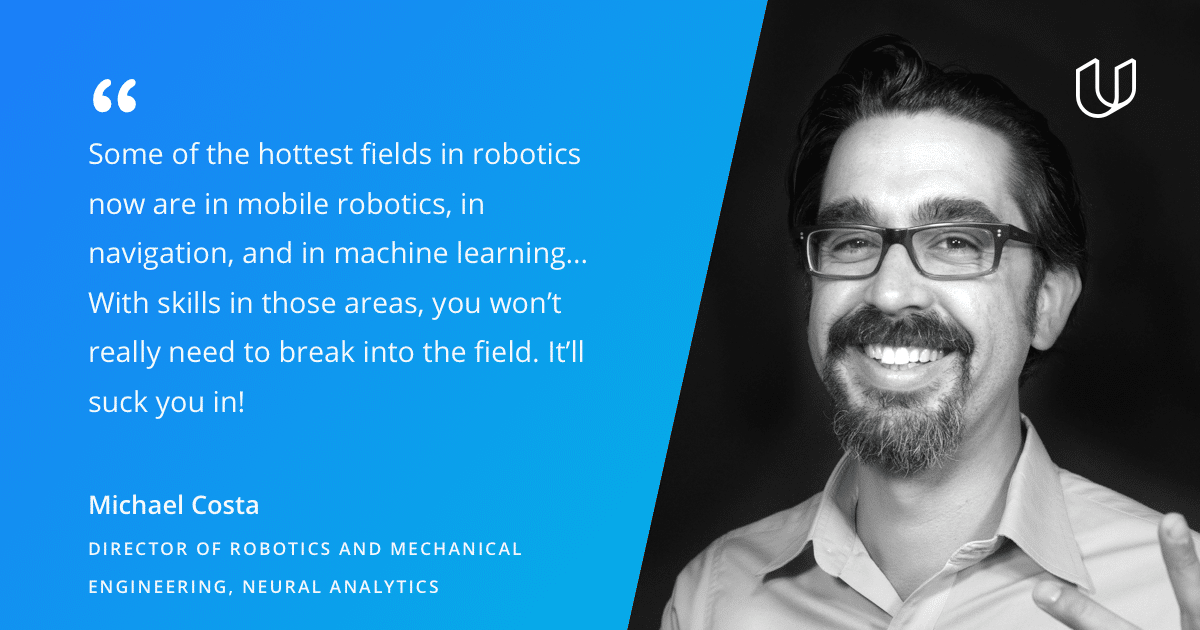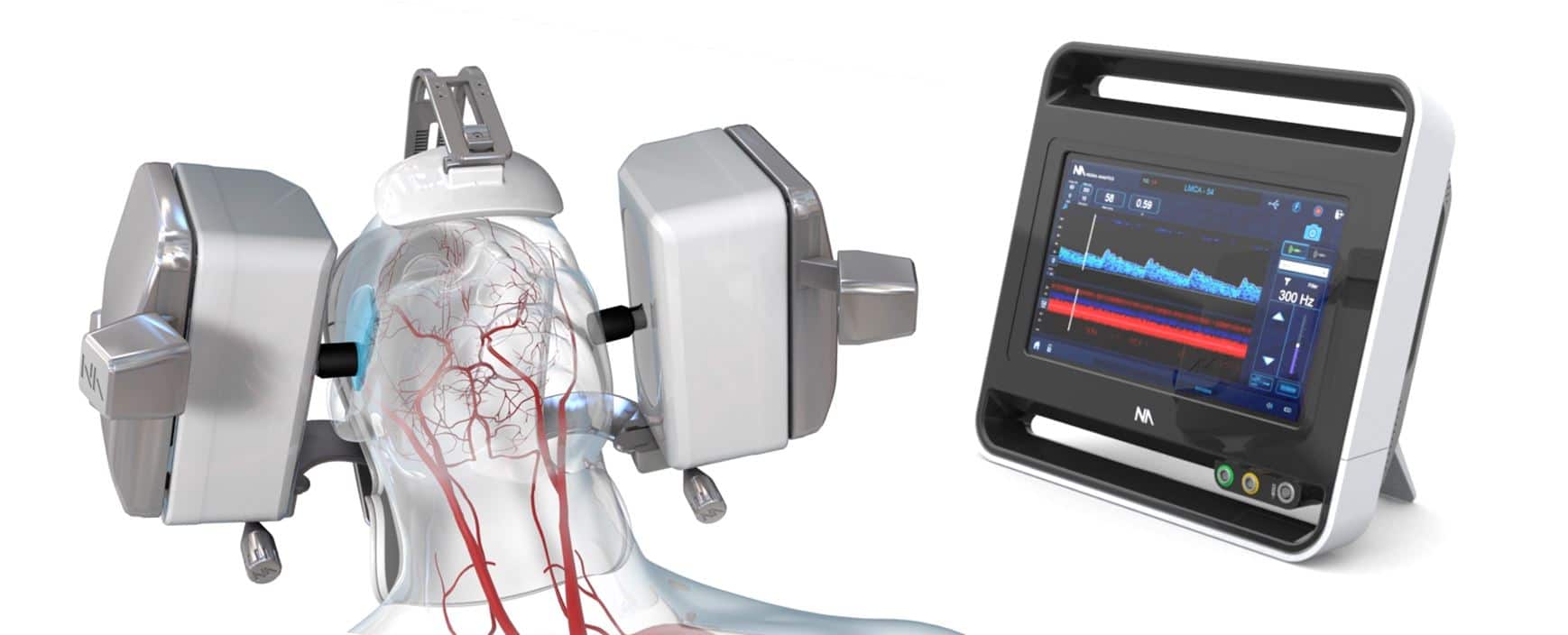Become a robotics software engineer.
Start Learning
We recently opened enrollments for the new class of Udacity’s Robotics Software Engineer Nanodegree program. In it, you’ll focus on building a portfolio of five hands-on projects using ROS and C++ (the most important programming language in robotics) and you’ll learn core robotics algorithms.
As we prepare to get started in a few weeks time, we thought it would be useful to speak with someone who already works in robotics to get an insider view on the robotics sector. We recently caught up with Michael Costa, a robotics engineer who has a passion for working with medical devices.

He gave us a great insight into his career journey and some great advice on how someone new to robotics can land their first position.
Thanks so much for sharing your career story with us today Michael. Can you start by telling us what first sparked your interest in robotics?
This is going to sound really trite, but I am going to be honest: it was Star Wars. I’m a Gen X’er who originally saw it in the movie theaters in 1977 as a five-year-old. My favorite character? R2-D2. First action figure? R2-D2. Favorite play-set? The Star Wars Droid Factory—the one where you could mix and match robot parts into your own creation. When I first saw the movie, I thought C-3PO and R2-D2 were real robots that Hollywood had somehow invented for the movies!
So how did you start translating that early obsession with Star Wars into an actual career in robotics?
I studied mechanical engineering, but I stopped doing the mechanism and part design pretty early on. Instead, I focused on embedded programming for mechatronic systems, controls theory (so I could model and control those mechatronic systems), and the kinematics and dynamics of robot arms.
While I was doing an internship at NASA Ames Research Center in Mountain View, I randomly saw that a robotics lab had opened at Ames, and I immediately knew that building robots is what I wanted to do. I put in for an internal transfer and started changing all my courses to accommodate robotics.
Is this where you started gaining practical robotic experience?
At first, I built up my experience by doing class projects and figuring out anything to get the project done. My lab mate and I convinced a NASA machinist to let us use the machine shop to build our upcoming class project during the winter break. After that it was one project after another—first to support Mars Rover experiments in using virtual reality for remote geology, then my Ph.D. projects at Stanford, and so on.
It sounds like you built some really great experience. What did you do next?
After doing robotics in undergrad and grad school for about eight years, I actually took a brief break from engineering to try something different. I went overseas and took a position in management consulting. I liked it while I was learning the role, but quickly got frustrated in the rote daily work. One day, I was in the Lisbon office reading a client’s magazine, and read about a company doing robotic heart surgery. It was a company that had wowed me about two years earlier in grad school during a seminar. I knew then that I had to get back into the robotics game.
And that’s when you moved back to the San Francisco Bay Area and landed a robotics role?
To start, I got a job with a company that did automation for the semiconductor industry. I was happy to be doing mechatronics and some robotics, but never really felt motivated by my contributions to build more memory for iPods. Just as I was starting to think about finding something else, I got a call from Intuitive Surgical—the same company I’d read about that was doing robotic surgery. They offered me a role, and through it I found a real passion for the intersection of medical devices and robotics.
What do you think it is about working in the medical industry that you fell in love with?
The safety critical aspect of the job intimidated me at first because I was writing surgical arm fault detection and motion control code. If I shipped a bug it could mean someone being denied care, or worse, being seriously injured during surgery. After a while I found that I wanted that edge to keep it interesting—anything else just wasn’t serious enough.
It’s really easy in medical devices to appreciate that what you do can affect people in a very direct and personal way. If your medical device company is doing things right, you’ll have a very strong sense of mission.
You now work for a startup—still in the medical sector. Can you give us a flavor of what you work on?
I am now the Director of Robotics and Mechanical Engineering for Neural Analytics (NA), a startup that is combining transcranial Doppler ultrasound technology with robotics and machine learning to measure brain blood flow for stroke diagnosis. My role has evolved during the past four years as the company has grown, but has always been centered around the robotics part of our product. When I first joined as employee number ten, I worked on early product requirements—building a cross-functional hardware engineering team, architecting the robot controls, kinematic analysis, and project managing the first prototype.

The coolest project I have worked on has been the NeuralBot TCD accessory, which received FDA approval last May. It’s been used during open heart surgery to monitor patients for emboli created during the procedure which can lead to stroke.
What advice would you give to someone looking to break into the field?
Because robotics is such a wide field with specializations across all disciplines, it’s really hard to point to specific areas that someone should study. A person designing new robotic mechanisms is going to need very different skills from someone working on machine vision for mobile robots.
Because of this variety, someone wanting to get into robotics should aim to develop skills that are traditionally outside of their discipline. A great way to do this is with projects that require integrating separate subsystems together. One of those skills should be programming.
Where do you see the biggest opportunities for careers in robotics right now?
I think some of the hottest fields in robotics now are in mobile robotics, in navigation, and in machine learning. I don’t see that changing in the next few years. With skills in those areas, you won’t really need to break into the field. It’ll suck you in!
What advice would you have wanted yourself when you first became interested in robotics?
My advice to my younger self would have been to keep up a second way to express my work. I can take robotics theory to model the physical world and turn it into servo control code, but it would have been nice to have kept up the practical skills of detailed mechanical design. Having two different ways to manifest your work will make you into a more versatile engineer.
˜
To start building the skills you need to begin your own career in robotics, enroll in Udacity’s Robotics Software Engineer Nanodegree program today. The next class begins on January 29. Register before January 23 and get 10% off using the code NY2019!





